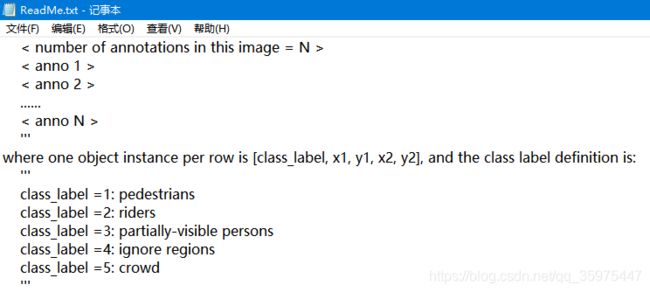关于WiderPerson数据说明(使用后笔记)
0.数据下载
0.1 官方下载
数据主页(包含google云盘、百度云盘下载方式)
Google Drive or Baidu Drive (jx5p)
0.2 我自己的csdn链接
WiderPerson.zip官网下载
数据解压之后:
1.不同目录下说明
1.0 ReadMe.txt
关于该数据集的解释,我主要关注的类别对应的标签:
1.1 Annotations
以.jpg.txt结尾~,好吧。其中000040.jpg.txt去掉了,因为坏掉了,特意下载了官方数据做了进一步确认,所以包括jpg也一起删掉了。还有一件比较重要的事,test的标注是没有的,所以Annotations中是不包含test.txt中文件名对应的.jpg.txt标注的。
下面是txt文件,第一行是目标数,第二行开始,第一列是类别,2-5列是坐标。
(
objection_numlabel xmin ymin xmax ymax)
1.2 Evaluation
主要是一些matlab的脚本,由于本人电脑比较烂,就不装这些了,对于Widerperson转VOC数据的,WiderPerson行人检测数据集,这篇写得是极好的了。
1.3 Images
这个文件夹下,就是包含所有的训练、验证、测试的图像了。
图有各种各样的从网上download下来的那种,水印还在呢,所以够一般化。
尺寸有几百到几千不等,所以有些也可以自己去掉,对于只像用其中几个类别的,可以在写csv文件的时候,去掉。
下面写了个小脚本,提取我想要类别的数据,然后写到csv文件中(name,filename,height,width,xmax,xmin,ymax,ymin)。
__author__ = 'gmt'
#将文件中的核心数据提取出来
import json
import random
import copy
import os
import cv2
if __name__ == '__main__':
infos = ['train_info', 'valid_info', 'test_info']
# infos=read_top(r"./csvdata/TownCentre-groundtruth.top")
# anno_path = './WiderPerson/Annotations/'
imgs_path = './WiderPerson/Images/'
train_info = './WiderPerson/train.txt'
valid_info = './WiderPerson/val.txt'
test_info = './WiderPerson/test.txt'
train_fp=open('./csvdata/pedestrain_train.csv','w')
valid_fp=open('./csvdata/pedestrain_valid.csv','w')
test_fp=open('./csvdata/pedestrain_test.csv','w')
# train_fp.writelines("class,filename,height,width,xmax,xmin,ymax,ymin\n")
# valid_fp.writelines("class,filename,height,width,xmax,xmin,ymax,ymin\n")
# test_fp.writelines("class,filename,height,width,xmax,xmin,ymax,ymin\n")
name = "pedestrain"
count = 0
for info_i in infos:
if info_i == 'train_info':
info = train_info
fp=train_fp
elif info_i == 'valid_info':
info = valid_info
fp=valid_fp
else:
info = test_info
fp=test_fp
fp.writelines("class,filename,height,width,xmax,xmin,ymax,ymin\n")
with open(info, 'r') as f:
img_ids = [x for x in f.read().splitlines()]
for img_id in img_ids: # '000040'
count += 1
print("count: " + str(count))
filename = img_id + '.jpg'
img_path = imgs_path + filename
img = cv2.imread(img_path)
height = img.shape[0]
width = img.shape[1]
label_path = img_path.replace('Images', 'Annotations') + '.txt'
if not os.path.exists(label_path):
continue
with open(label_path) as file:
line = file.readline()
count_p = int(line.split('\n')[0]) # 里面行人个数
print("count: " + str(count) + " , count_p: " + str(count_p))
line = file.readline()
while line:
cls = int(line.split(' ')[0])
# < class_label =1: pedestrians > 行人
# < class_label =2: riders > 骑车的
# < class_label =3: partially-visible persons > 遮挡的部分行人
# < class_label =4: ignore regions > 一些假人,比如图画上的人
# < class_label =5: crowd > 拥挤人群,直接大框覆盖了
# if cls == 1 or cls == 2 or cls == 3:
if cls == 2:
xmin = float(line.split(' ')[1])
ymin = float(line.split(' ')[2])
xmax = float(line.split(' ')[3])
ymax = float(line.split(' ')[4].split('\n')[0])
fp.writelines("%s,%s,%d,%d,%s,%s,%s,%s\n"%(name,filename,height,width,xmax,xmin,ymax,ymin))
line = file.readline()
cv2.imshow('result', img)
cv2.waitKey(10)
train_fp.close()
valid_fp.close()
test_fp.close()
检测框在图像上可视化:
import os
import cv2
if __name__ == '__main__':
path = './WiderPerson/train.txt'
with open(path, 'r') as f:
img_ids = [x for x in f.read().splitlines()]
for img_id in img_ids: # '000040'
img_path = './WiderPerson/Images/' + img_id + '.jpg'
img = cv2.imread(img_path)
im_h = img.shape[0]
im_w = img.shape[1]
label_path = img_path.replace('Images', 'Annotations') + '.txt'
if not os.path.exists(label_path):
continue
with open(label_path) as file:
line = file.readline()
count = int(line.split('\n')[0]) # 里面行人个数
line = file.readline()
while line:
cls = int(line.split(' ')[0])
# < class_label =1: pedestrians > 行人
# < class_label =2: riders > 骑车的
# < class_label =3: partially-visible persons > 遮挡的部分行人
# < class_label =4: ignore regions > 一些假人,比如图画上的人
# < class_label =5: crowd > 拥挤人群,直接大框覆盖了
if cls == 1 or cls == 2 or cls == 3:
xmin = float(line.split(' ')[1])
ymin = float(line.split(' ')[2])
xmax = float(line.split(' ')[3])
ymax = float(line.split(' ')[4].split('\n')[0])
img = cv2.rectangle(img, (int(xmin), int(ymin)), (int(xmax), int(ymax)), (0, 255, 0), 2)
line = file.readline()
cv2.imshow('result', img)
cv2.waitKey(500)
1.4 关于几个txt文件
以train.txt为例吧,因为每个文件里都是文件名,所以不赘述。
2.个人评价
优点:数据量大,各种场景下密集人群都包含。
缺点:都是单帧图像,对于想使用其中的测试集,做跟踪,基本不用考虑了。还是自己乖乖地去录段小视频吧~~~
参考
1.WiderPerson行人检测数据集







